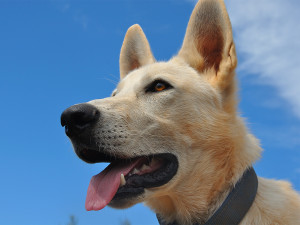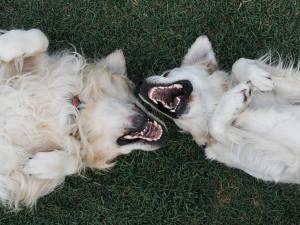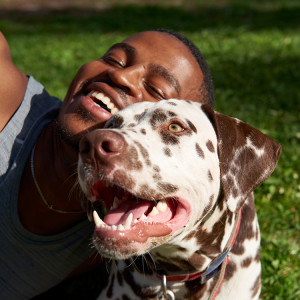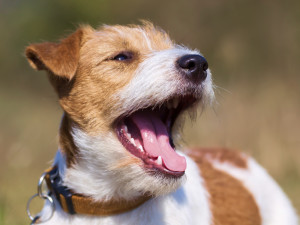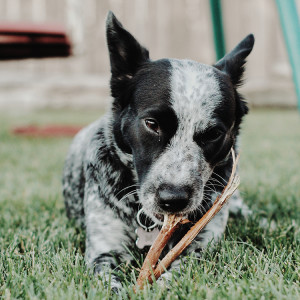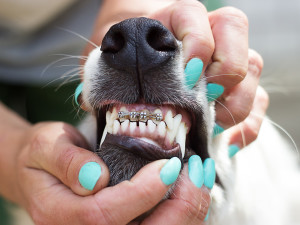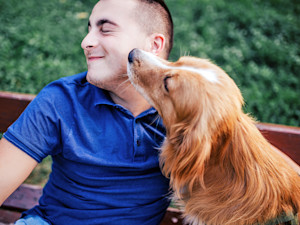They’re Just Like Us: Dogs Get Gingivitis
Dogs can suffer from gum disease, too. Here’s how to prevent it.

Share Article
You’re probably well aware of the warnings against human gingivitis — they’ve likely been scared into you by dentists who are a little suspicious of your self-reported flossing habits. But as it turns out, humans aren’t the only ones who can get the gum disease; dogs are at risk, too. And the condition’s no joke: Gingivitis in dogs causes inflammation of the gums around the teeth and can lead to more serious health conditions, such as kidney, liver, and heart disease. The good news is, it can be prevented. Here’s how.
Symptoms Of Gingivitis in Dogs
Until gingivitis reaches an advanced stage, it can be difficult to detect, so your dog may not exhibit symptoms at first. That’s why it’s important to get their teeth regularly checked at the vet. The tell-tale signs of advanced gingivitis are:
Inflamed red gum line where the gums meet the teeth
Swollen gums
Excessive plaque and tartar buildup
Bleeding gums, especially when brushing teeth
Receding gums
Loose teeth
What Causes Gingivitis in Dogs?
Dr. Bert Dodd, a clinical professor at the Texas A&M University College of Veterinary Medicine and Biomedical Sciences, says that gingivitis in dogs is very common, and every dog has it — to some degree.
Just like in humans, gingivitis in dogs is caused by plaque buildup on the tooth, which is made up of food, saliva, and bacteria. Through an interaction between these foreign bacteria and the body’s immune system, enzymes are released that break down the gum tissue, leading to inflammation.

At more advanced stages, buildup can lead to chronic pain and gum erosion. “If left untreated, gingivitis leads to periodontitis, or inflammation and destruction of the hard tissues around the tooth,” Dr. Dodd says. “In addition to increasing the potential for heart, kidney, and liver disease, unchecked gingivitis may result in missing teeth and bone loss in severe cases.”
How to Prevent Gingivitis in Dogs
Luckily, gingivitis can be easily prevented through routine oral care habits. Dr. Dodd recommends brushing your dog’s teeth daily to remove harmful bacteria and prevent a buildup of plaque. Although some dogs may be resistant to having their teeth brushed at first, over time, a regular routine will acclimate them. Human toothpaste is toxic to animals, but special dog toothbrushes and toothpastes can be purchased from most pet supply stores.
Dr. Dodd also recommends having your dog’s teeth professionally cleaned every year. If your dog does develop gingivitis, it can be managed through teeth cleaning and debridement, or the surgical removal of damaged tissue by a veterinarian.
Again, it may take some time, but establishing a proper dental hygiene routine for your dog is crucial. Not only will you keep their pearly whites sparkling, you’ll also prevent some serious health conditions from surfacing later in life.

Jennifer Gauntt
Jennifer Gauntt, MA, is the communications director at Texas A&M University College of Veterinary Medicine & Biomedical Sciences, where she covers scientific advancements in pet heath and behavior. This story was originally published by Pet Talk, a service of the College of Veterinary Medicine & Biomedical Sciences, Texas A&M University. Original stories can be viewed on the web at vetmed.tamu.edu/news/pet-talkopens in new tab. May be edited for style and length.
Related articles
![Photo of small terrier dog outside int he sun with mouth open, teeth and tongue visible]()
Do Small Dogs Have Bigger Dental Issues?
A new study finds that small dog breeds are at higher risk for dental disease.
![Brown Labrador lifting front leg]()
How to Get a Head Start on Your Pet’s Health
Spot lumps, limps, and lethargy early on.
![A smiling man with short black hair sitting on the grass outside leaning on his Dalmatian dog who is also smiling showing clean teeth]()
12 Dental Products to Keep Your Dog’s Teeth Gleaming
The toothbrushes, dental wipes, and breath fresheners that’ll keep your pup smiling.
![Dog in the grass outside chewing on a bully stick]()
Chew on This: A Guide to Safe and Not-So-Safe Dog Bones
Two experts—a veterinary dentist and internist—rate the most popular dog bones.
![A person holding a dogs mouth open showing its braces.]()
Why Dog Orthodontics Exist and Your Pup May Need Them
Braces are actually the most gentle way of dealing with your dog’s malocclusion (aka a “bad bite”).
![Man leaning away from dog's face outside.]()
Here’s Why Your Dog’s Breath Is the Worst
It might be a sign of a bigger issue.
